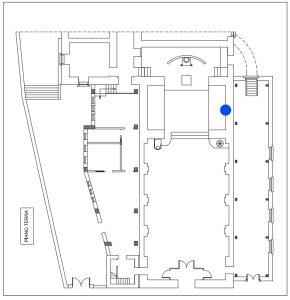Scultura San Pietro Nolasco



Parrocchia Santuario Maria SS. di Carpignano
Scultura
San Pietro Nolasco
Ambito italiano
Sec. XX
Legno scolpito e dipinto

Parish Sanctuary Maria SS. di Carpignano
Sculpture
San Pietro Nolasco
Italian area
XX century
Carved Wood
La scultura, raffigurante il santo fondatore dell’ordine, San Pietro Nolasco, proviene da uno dei conventi italiani soppressi dell’ordine mercedario. Fu trasportata a Carpignano durante gli anni Ottanta del Novecento per interessamento dell’allor superiore del convento Padre Pasquale Pasquariello.
Il santo spagnolo è qui raffigurato con gli attributi più significativi della sua vita: l’abito con lo stemma dell’ordine, le catene infrante, il libro della Bibbia aperto con un verso del salmo 110: “Redemptiónem misit pópulo suo” (Ha mandato la redenzione al suo popolo), un ex schiavo ai piedi del Santo.
Biografia di San Pietro Nolasco
Pietro Nolasco nacque e visse nel contesto medievale di Barcellona ed, in particolare nel suo porto marittimo ove svolse, fin da giovane, il lavoro di mercante, ereditato da suo padre. Nel suo contatto con il porto di Barcellona e con le rive del Mediterraneo scoprì la piaga della schiavitù che toccherà per sempre il suo cuore e lo spingerà ad imbarcarsi con l’intento di redimere gli schiavi investendo direttamente i suoi beni e coinvolgendovi anche i suoi amici. Nacque così la “Mercede” come piccola comunità di fratelli redentori con lo scopo di raccogliere le elemosine “per redimere” gli schiavi. Questa comunità diventerà un ordine religioso il 10 agosto del 1218.
Le case della Mercede sorsero in tutto il sud della Francia, in Catalogna, a Maiorca, a Valencia, ad Aragona ed a Castiglia, portando il messaggio di libertà non solo per le strade polverose della Penisola ma attraverso il Mediterraneo. Nel 1235, il Papa Gregorio IX confermò l’Ordine con la bolla Devotionis vestrae. Il suo pellegrinaggio terreno ebbe termine a Barcellona, nel suo convento costruito nell’arenile di Villanova, vicino al mare, il 6 maggio 1245. La Congregazione dei Riti ne approvò il culto il 30 settembre 1628, e il 19 giugno 1655 il suo nome fu inserito nel Martirologio Romano. Il papa Alessandro VII estese il suo culto a tutta la Chiesa l’11 giugno 1664.
A cura dei Padri Mercedari
The sculpture, depicting the founding saint of the order, San Pietro Nolasco, comes from one of the suppressed Italian convents of the mercedary order. It was transported to Carpignano during the eighties of the twentieth century by the interest of the then superior of the convent Father Pasquale Pasquariello.
The Spanish saint is depicted here with the most significant attributes of his life: the dress with the coat of arms of the order, the broken chains, the book of the Bible opened with a verse from Psalm 110: “Redemptiónem misit pópulo suo” (He sent redemption to his people), a former slave at the feet of the Saint.
Biography of San Pietro Nolasco
Pietro Nolasco was born and lived in the medieval context of Barcelona and, in particular in its seaport where, from an early age, he carried out the work of a merchant, inherited from his father. In his contact with the port of Barcelona and with the shores of the Mediterranean he discovered the scourge of slavery that will forever touch his heart and push him to embark with the intent of redeeming the slaves by investing his goods directly and also involving his friends. Thus, the “Mercede” was born as a small community of redeeming brothers with the aim of collecting alms “to redeem” the slaves. This community will become a religious order on 10th August 1218.
The houses of La Mercede sprang up throughout southern France, Catalonia, Mallorca, Valencia, Aragon and Castile, carrying the message of freedom not only to the dusty streets of the Peninsula but across the Mediterranean. In 1235, Pope Gregory IX confirmed the Order with the bull Devotionis vestrae. His earthly pilgrimage ended in Barcelona, in his convent built on the beach of Villanova, near the sea, on 6th May 1245. The Congregation of Rites approved its cult on 30th September 1628, and on 19th June 1655 its name was inserted in the Roman Martyrology. Pope Alexander VII extended his cult to the whole Church on 11th June 1664.
By the Mercedary Fathers
